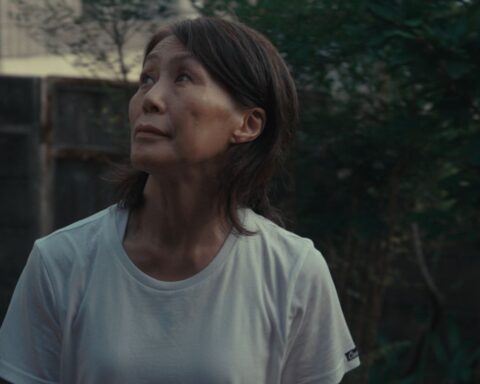A nearly full house gathered at Innis Town Hall for Hot Docs 2015’s special one-night-only performance of Highrise: Universe Within, Live. The last instalment of Katerina Cizek and the NFB’s groundbreaking digital documentary project presents some two-dozen short multimedia “stories” exploring the “hidden digital lives” of highrise-dwellers around the world. With live music performed by Dafydd Hughes and Nick Storring, the gregarious Misha Glouberman took the helm as host for the evening. Audience members volunteered to go on stage and respond to a series of multiple-choice questions posed by Glouberman about their relationship with digital technology. Each response triggered the playback of a different story set in locations as diverse as Seoul or Mexico City, Baku or Rome. Kinect devices were used to create 3D-esque renderings of Glouberman and the audience participants, which were superimposed on the backdrop of the website’s interface and projected on the large screen above the stage, integrating the performative and curated worlds of the live experience with elegance.
The most emotionally impactful story of the evening was the last of seven and began with the question, “How fulfilling is intimacy for you over the internet?” The audience participant on stage selected a negative response, prompting the heart-wrenching story of a woman from the West Bank whose parents, a mere one hour drive away in Gaza, have been unable to secure Israeli travel permits to attend her wedding and other major life cycle events. The limitations of digital communication were on painful display as we witness the woman introducing her infant daughter to her parents by means of a shaky Skype connection, a woeful substitute for the real thing.
Universe Within, Live offered a compelling example of the rich potential that exists in the largely unexplored realm of the interactive documentary as collective experience. This was a very different beast than what the same project will be for individual users on a personal computer. Audience members at Innis were actively engaged with the seven stories from around the world, sharing their own thoughts and experiences, creating a memorable interpersonal discourse filled with laughter and surprises. The power of the transformation from passive consumption to active participation was striking.
While live performance is obviously imbued with a power all its own, there’s no inherent reason why the interactive doc as collective experience has to be limited to live performance events. The crucial question we should be asking in terms of design is whether an individual online user need be the sole intended audience for interactive projects. It’s easy to imagine a classroom of students engaging with interactive doc experiences designed to foster interaction both on- and off-screen—surely this is a direction the NFB should actively pursue with its interactive programming, just as it always has with its conventional documentaries. Just as interactive documentary will never replace conventional linear documentary, likewise there is no reason to think that interactive docs intended for collective experience will replace those designed for individuals; these are not competing paradigms, but complementary forms, each with their own distinct narrative and communicative capacities.
Heading in a different direction altogether, there’s no reason why such experiences couldn’t enter the mainstream and be featured alongside movies and TV shows on Netflix and other digital distribution platforms. With its simple navigation demanding no more than a remote control, Universe Within would be a perfect test case. Interactive docs could be designed with settings that tailor the experience for one, five, ten, or however many users. The limiting factor here is our collective imagination about what kind of content “belongs” on a TV, a computer, or even a theatre screen.
Universe Within: Digital Lives in the Global Highrise is online now. Cizek discussed the upcoming chapter with POV in February 2015.








